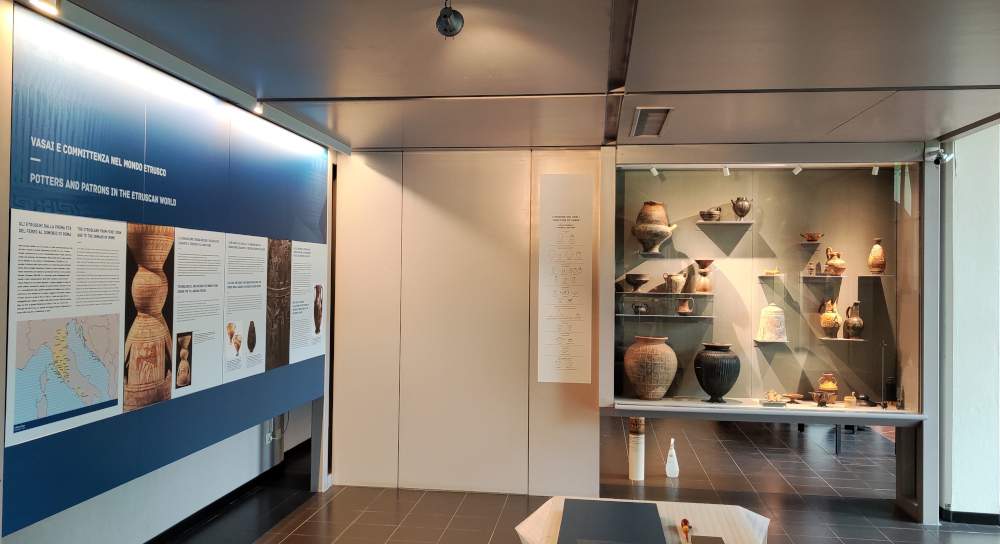The MIC in Faenza will inaugurate the new display of classical ceramics on Saturday, May 6, at 5 p.m. After more than two decades, the exhibition will be significantly revised, as much in its educational content and selection of artifacts as in its graphic design.
“The updating of the artifacts,” specifies conservator Valentina Mazzotti, coordinator of the rearrangement project, “will bring to the exhibition a nucleus of objects from the deposits (15 percent for the Classical part and 37 percent for the Roman part), which will be presented to the public for the first time, after a careful review of their state of preservation. In addition, the exhibition itinerary will be updated, offering a cultural-historical framework for the Greek-Etruscan part, as opposed to the Roman part with a thematic-functional presentation, which will highlight the use of ceramics (and more) in various aspects of daily life.”
“The new exhibition proposal of the ceramics of Greece and Italy in classical antiquity,” explains curator Andrea Gaucci, “is in continuity with the previous one, reorganizing the showcases on the basis of four major cultural-historical thematic areas and offering some insights. The guiding principle of the exhibition is the dialogue between Greece and Italy. The itinerary opens with Aegean ceramics from the Bronze Age, Phoenician ceramics and Greek ceramics from the Archaic period, and then continues by highlighting the production of Athens Ceramics, whose role in the Mediterranean between the 6th and 4th centuries B.C. was prominent. This is followed by the fruitful Apulian productions of Greek and indigenous traditions, and then those of the Etruscan world. Specific insights are offered in parallel: Attic ceramics and local production at Spina, the Etruscan port in the Po Delta; indigenous ceramics of ancient Apulia influenced by the Greek world and other figured colonial productions in southern Italy; and Etruscan bucchero.”
This will be followed by the new display of Roman ceramics. “The wide and varied use of ceramic objects in the Roman age,” says curator Anna Gamberini, “suggested that a thematic and functional criterion be followed for the new display, highlighting the use of fictile objects as much in the preparation, cooking and consumption of food and drink as in the transportation of foodstuffs, as well as in other aspects of daily life: from personal care to the lighting of rooms, and the construction and decoration of buildings. The materials in the current exhibition have been joined by a selection of those stored in the warehouses, with special emphasis on artifacts from excavations in Faenza. Those referable to the Roman city (Faventia) testify to the existence of ceramic productions in this center.”
An important enrichment of the Roman selection will concern the possibility of exhibiting a portion of thelarge floor mosaic found in 1971-1972 during the archaeological excavation of the domus in Via Dogana in Faenza, currently kept in the Soprintendenza’s deposits at Palazzo Mazzolani in Faenza. “This new acquisition of the MIC’s exhibition itinerary,” says director Claudia Casali, “is the result of fruitful collaborations between local heritage protection and enhancement realities, and I would like to thank Superintendent Gonzato and the officials of the Soprintendenza Archeologia, Belle Arti e Paesaggio for the provinces of Ravenna, Forlì-Cesena and Rimini for their willingness to collaborate on the project with a view to greater enjoyment and promotion of our local heritage. Finally, for the overall realization of the new layout and the related guide, special thanks go to the curators Andrea Gaucci and Anna Gamberini and in general to the Department of History Cultures Civilizations of the Alma Mater Studiorum - University of Bologna, with which we have been establishing an effective relationship of study and research of materials for several years. The guide to classical ceramics will be the first in a new series dedicated to in-depth studies of our heritage.”
The MIC guidebook series is published by Silvana Editoriale.
The new exhibition project and the related guidebook were made possible thanks to a grant from the General Directorate for Education, Research and Cultural Institutes of the Ministry of Culture" thanks to the support of LA BCC.
 |
| Faenza's MIC updates and renews classical ceramics section |
Warning: the translation into English of the original Italian article was created using automatic tools. We undertake to review all articles, but we do not guarantee the total absence of inaccuracies in the translation due to the program. You can find the original by clicking on the ITA button. If you find any mistake,please contact us.